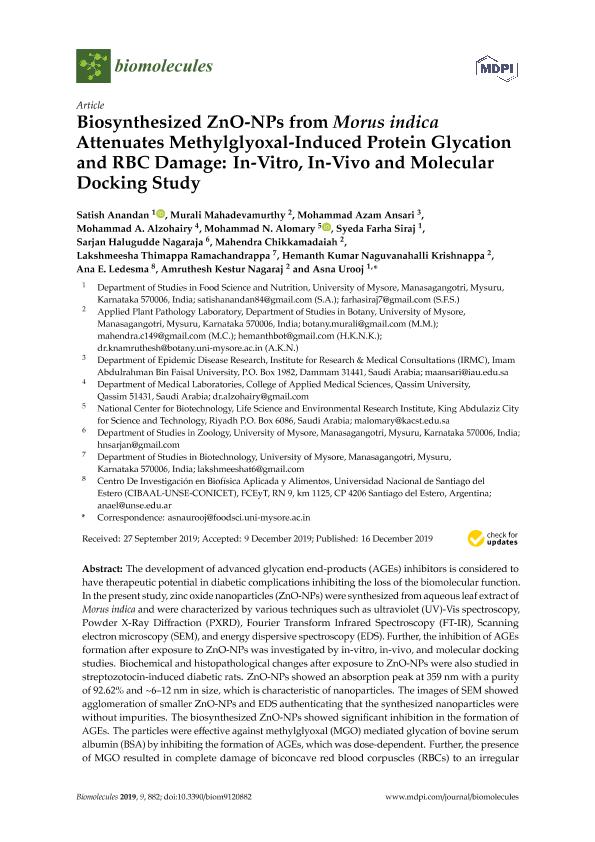Artículo
Biosynthesized ZnO-NPs from Morus indica attenuates methylglyoxal-induced protein glycation and RBC damage: In-vitro, in-vivo and molecular docking study
Anandan, Satish; Mahadevamurthy, Murali; Ansari, Mohammad Azam; Alzohairy, Mohammad A.; Alomary, Mohammad N.; Siraj, Syeda Farha; Nagaraja, Sarjan Halugudde; Chikkamadaiah, Mahendra; Ramachandrappa, Lakshmeesha Thimappa; Krishnappa, Hemanth Kumar Naguvanahalli; Ledesma, Ana Estela ; Nagaraj, Amruthesh Kestur; Urooj, Asna
; Nagaraj, Amruthesh Kestur; Urooj, Asna
 ; Nagaraj, Amruthesh Kestur; Urooj, Asna
; Nagaraj, Amruthesh Kestur; Urooj, Asna
Fecha de publicación:
12/2019
Editorial:
Multidisciplinary Digital Publishing Institute
Revista:
Biomolecules
ISSN:
2218-273X
Idioma:
Inglés
Tipo de recurso:
Artículo publicado
Clasificación temática:
Resumen
The development of advanced glycation end-products (AGEs) inhibitors is considered to have therapeutic potential in diabetic complications inhibiting the loss of the biomolecular function. In the present study, zinc oxide nanoparticles (ZnO-NPs) were synthesized from aqueous leaf extract of Morus indica and were characterized by various techniques such as ultraviolet (UV)-Vis spectroscopy, Powder X-Ray Diffraction (PXRD), Fourier Transform Infrared Spectroscopy (FT-IR), Scanning electron microscopy (SEM), and energy dispersive spectroscopy (EDS). Further, the inhibition of AGEs formation after exposure to ZnO-NPs was investigated by in-vitro, in-vivo, and molecular docking studies. Biochemical and histopathological changes after exposure to ZnO-NPs were also studied in streptozotocin-induced diabetic rats. ZnO-NPs showed an absorption peak at 359 nm with a purity of 92.62% and ~6–12 nm in size, which is characteristic of nanoparticles. The images of SEM showed agglomeration of smaller ZnO-NPs and EDS authenticating that the synthesized nanoparticles were without impurities. The biosynthesized ZnO-NPs showed significant inhibition in the formation of AGEs. The particles were effective against methylglyoxal (MGO) mediated glycation of bovine serum albumin (BSA) by inhibiting the formation of AGEs, which was dose-dependent. Further, the presence of MGO resulted in complete damage of biconcave red blood corpuscles (RBCs) to an irregular shape, whereas the morphological changes were prevented when they were treated with ZnO-NPs leading to the prevention of complications caused due to glycation. The administration of ZnO-NPs (100 mg Kg−1) in streptozotocin(STZ)-induced diabetic rats reversed hyperglycemia and significantly improved hepatic enzymes level and renal functionality, also the histopathological studies revealed restoration of kidney and liver damage nearer to normal conditions. Molecular docking of BSA with ZnO-NPs confirms that masking of lysine and arginine residues is one of the possible mechanisms responsible for the potent antiglycation activity of ZnO-NPs. The findings strongly suggest scope for exploring the therapeutic potential of diabetes-related complications.
Palabras clave:
glycation
,
in-vivo
,
diabetes
,
methylglyoxal
,
molecular docking
,
ribose
,
ZnO-NPs
Archivos asociados
Licencia
Identificadores
Colecciones
Articulos (CIBAAL)
Articulos de CENTRO DE INVESTIGACION EN BIOFISICA APLICADA Y ALIMENTOS
Articulos de CENTRO DE INVESTIGACION EN BIOFISICA APLICADA Y ALIMENTOS
Citación
Anandan, Satish; Mahadevamurthy, Murali; Ansari, Mohammad Azam; Alzohairy, Mohammad A.; Alomary, Mohammad N.; et al.; Biosynthesized ZnO-NPs from Morus indica attenuates methylglyoxal-induced protein glycation and RBC damage: In-vitro, in-vivo and molecular docking study; Multidisciplinary Digital Publishing Institute; Biomolecules; 9; 12; 12-2019; 1-19
Compartir
Altmétricas



